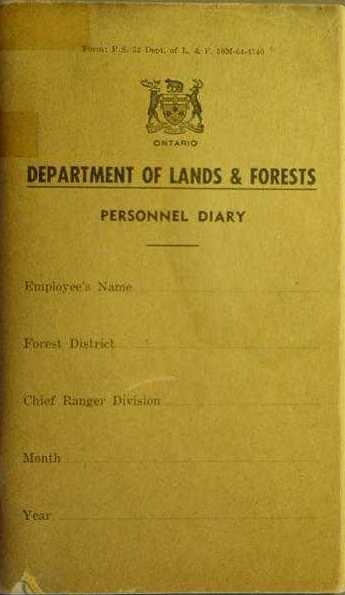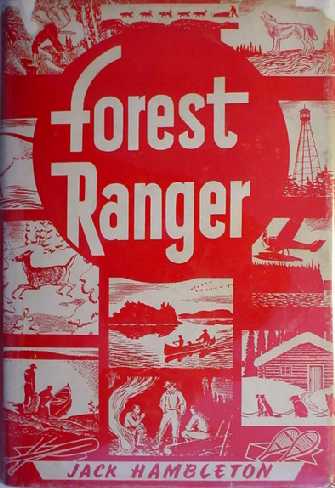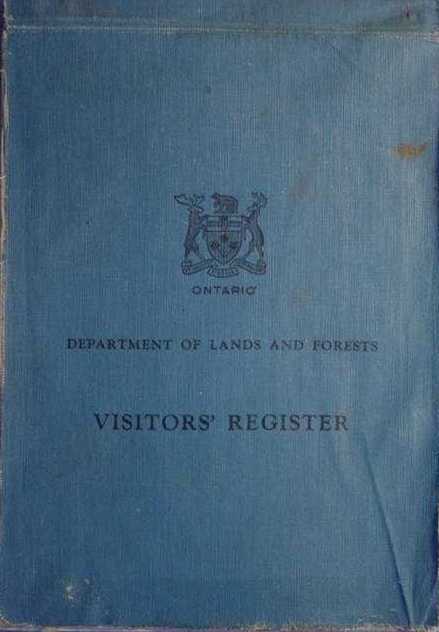
Each year in Ontario alone there are on average 1,400 forest fires, many of which go unheard of in the south. Most of these are caused by careless smokers and campers. According to an article in 'Forest Protection in Ontario: 1960,' "Perhaps the most serious single cause of forest fires is the careless smoker- usually unaware of how lethal his cigarette may be and so accustomed to throwing his butt on the city pavement: turned loose in forested areas, he becomes our number one menace." The single best way to stop a forest fire is to never let it start. Before our modern aerial fire detection system was organized, most fires were reported by the public and by Ontario's fire towermen.
The first fire tower lookouts across the province were wooden and erected at the turn of the century and after WW1. Most of these were about 35 ft. high. As the forest trees grew in height many of these were abandoned and 80 ft. steel towers were put up in their place in the 1920's and 1930's. The towers over time were grouped into twenty-two individual Ontario Fire Districts such as the Tweed, Parry Sound, North Bay, and Sudbury Fire Districts. Towers were arranged over the years in specific spots to get the best view possible between each tower. The Department of Lands and Forests (the MNR since 1972) would place cameras on 100 ft. poles and take photos at a 360 degree radius to get a look at the area that could be seen. Then they could determine where to erect a tower. Usually the best bet was to put an early warning tower on top of a naturally high elevation like a sloping hill. DLF employees would then erect each in the span of two weeks. This was not a job for the faint-hearted or those afraid of heights.
Being a towerman was seasonal work starting May 1st and ending Oct. 1st depending on weather conditions. They worked long daylight hours, especially in the summer months when there was a high fire index. The Forest Fire Index System was, and still is, used in Canada as a measure of fire hazard. According to ex- DLF employee Doug Mumford, "Most fires were located by using two towers giving the location of a fire on their map based on a 360 degree radius and we could pinpoint the degrees given to us by several towers to get the exact location of a fire." The tool they used to spot a smoke was called an alidade. It was mounted on a circular table with a map of the area and a degree ring to plot fire direction. The tower was plotted exactly in the centre of this map. The observer reported the compass direction, distance and size of the fire to headquarters by 'bush phone lines' in the early years and by two-way radio in later years. If other towers reported the fire then a 'fix' could be plotted on the map at headquarters. At headquarters there was a larger map of their assigned area and every tower was marked by a point which were circled by a larger compass index.
Most towermen were supplied with ham radios and live-in bunkhouses where they lived all summer. The towers were often so far back in the bush that commuting wasn't an option. It goes without saying that being married or raising a family was not always a part of a towerman's life during their tower tenures. Recently, however, I had the chance to talk with the wife of an ex-towerman. According to Mrs. Gloria Weight, who's husband ran the Lutterworth Fire Tower at Moore Falls, Haliburton, "As far as I know I was the only wife who got to spend the summer at a fire tower. I cooked on a little gas stove and met visitors to the tower. We raised our son there in the summer and he climbed the 85 ft. tower by the age of one. We only got to go into town for food and paycheques once a month during a rainfall."
Towers were erected by Dept. workers and the towermen. Some pieces were dropped in by plane in the winter and others were brought in and hauled up hills by horse in the spring. It would take about 2 weeks to assemble from the ground up, starting at the cement block base. The steel pieces weren't especially heavy and were bolted at each level. The top cabin or cupolas were hoisted up piece-by-piece and bolted at the joints. The heavy steel type was certainly well engineered considering the fact that during high winds they would never shift. Earlier light steel models had a tendancy to sway and shift in higher winds, and the odd one that wasn't bolted properly blew over, like the one at Lumsden Twp. in 1941.
The actual job could become boring at times, so many towermen I am told would play musical instuments- the most popular being the fiddle. During low fire index's, some towermen would play for other towermen in the area over their radios. One story has it that a certain fiddler was playing to all the towers across the province because he had depressed the wrong switch. (This was a theme used in an episode of "The Forest Rangers" when Chub plugged his guitar into a radio and all the other ranger and tower radios in the area could hear his deafening screaches without his even knowing it.)
Towermen were expected to keep logbooks of their daily activities, and they also had guestbooks available for any adventurous folks who decided to climb to the top for the views. These were handed to the main DLF offices in Toronto at the end of the season.
Around 1970, many towers and towermen were de-comissioned, but they weren't all abandoned. For a while they used a combination of fixed detection (towers) and aerial detection (planes) to pinpoint fire locations. Another reason towers became obsolete was because conditions during a high fire hazard produced haze that towermen had trouble seeing through, especially if a fire was in it's early stages.
Men and women could climb up the tower if they wished, even when the towerman was on duty. It wasn't an easy climb though. Going up was the easy part, but when one came to the opening of the cupola (the tower's top housing) things weren't so easy when one tried to manoeuver through the bottom opening. For many, the hardest part was the fear of going back down. The towerman would have to use a long rope to tie around the person's waist to lower them back down to the ground. This was the theme used in one of the old episodes of 'Adventures in Rainbow Country' where Hannah (played by Susan Conway) got scared and was trapped in the old Willisville Fire Tower. Pete Gawa had to rescue her with a long rope.
*I have become fascinated with the idea of the loneliness that each towerman must have faced each year. I am sure most people would say that they couldn't have handled such remoteness even if they received pay for it- not even for one summer. My sentiments would be similar except that I have a theory that might have lessened the sheer madness that must have entered the thoughts of each towerman at some point. The truth is that they really were not all that alone after all. I think it's kinda cool to remember that there were 320 other towermen in Ontario doing the exact same thing and that in reality each tower was connected to the next closest one, and so on. I mean, you could actually see at least one other tower from each location, and the next guy could see one, and so on, and so on. This even continued out into the next province; not to mention the fact that there were 1000's of other men doing the exact same thing around the globe. To me this was the romance behind the idea of actually being a towerman.
Check out the photos below of some of a towerman's tools (depending on your browser you may have to scroll down a bit) or go BACK to the main page. For a diagram and specs of an 80 foot heavy steel tower click here. For a list of all the towers still standing in the province click here.



